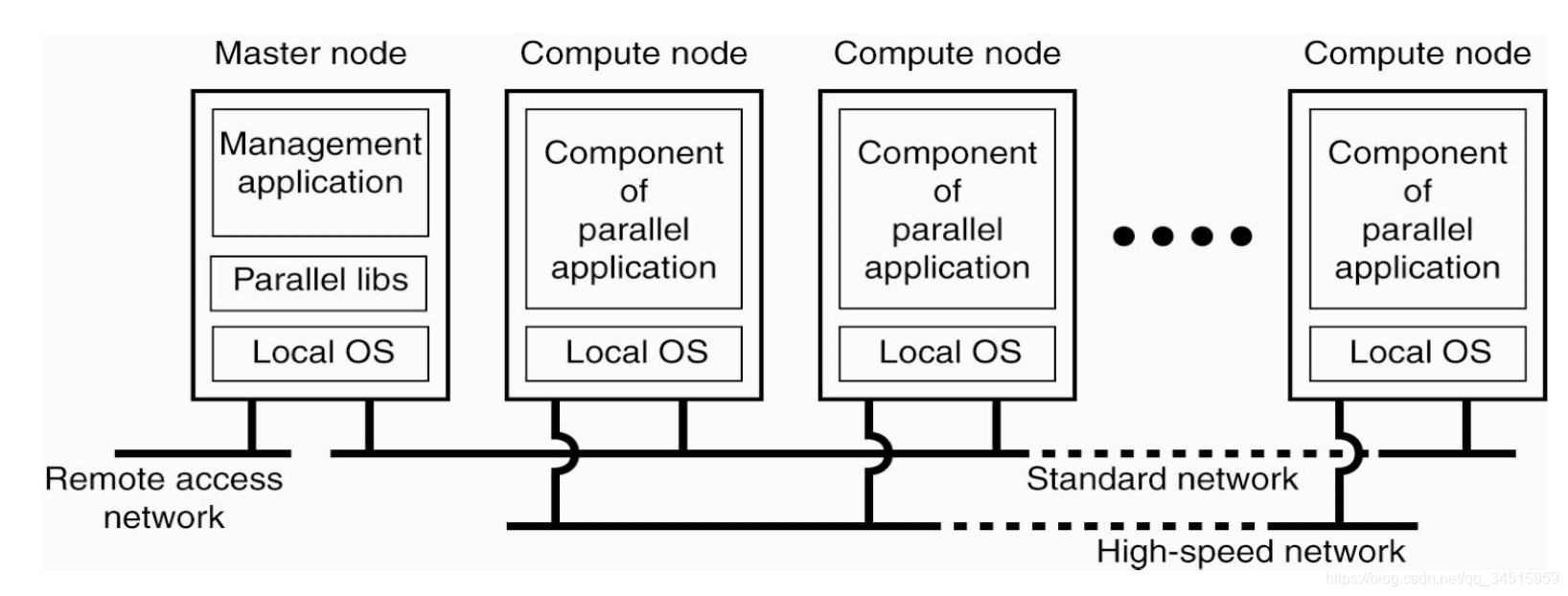Cluster Computing
More than one computer combine to form a cluster. It exhibits very high performance but from the end users perspective, they feel like working on a standalone system. Cluster computing follows distributed systems as its principle. LAN acts as the connection unit here. The Clustering methods encompass HPC IAAS, HPC PAAS, which are further luxurious and hard to set up and preserve than a single computer. A computer cluster helps to largely reduce the unavailability of these systems and provides larger storage to other desktop workstation or computer.
被组织的一些计算机成为集群。从用户的角度来看,集群像一个整体能提供强大的计算性能。集群计算遵从分布式设计的原则,通过局域网链接集群中的计算机节点。集群计算提供了高性能的云服务,但是它比单机计算更难搭建和维护。此外,集群计算能减少单机计算带来的性能浪费,并且可利用非专用机的台式机搭建集群减小成本。
Some of the most widely used Cluster Computers are Petroleum Reservoir Simulation, Google Search Engine, Earthquake Simulation, Weather Forecasting.

Grid Computing
Grid computing involves a group of networked computers that work together as a virtual supercomputer to perform large tasks, such as analysing huge sets of data or weather modelling. Through the cloud, you can assemble and use vast computer grids for specific time periods and purposes, only paying, if necessary, for what you use to save both the time and expense of purchasing and deploying the necessary resources yourself. Also, by splitting tasks across multiple machines, processing time is significantly reduced to increase efficiency and minimise wasted resources.
Unlike with parallel computing, grid computing projects typically have no time dependency associated with them. They use computers that are part of the grid only when idle, and operators can perform tasks unrelated to the grid at any time. Security must be considered when using computer grids, as controls on member nodes are usually very loose. Redundancy should also be built in, as many computers may disconnect or fail during processing.
Difference Between Cluster Computing VS. Grid Computing
When two or more computers are used together to solve a problem, it is called a computer cluster . Then there are several ways of implementing the cluster, Beowulf is maybe the most known way to do it, but basically it is just cooperation between computers in order to solve a task or a problem. Cluster Computing is then just the thing you do when you use a computer cluster.
Grid computing is something similar to cluster computing, it makes use of several computers connected is some way, to solve a large problem. There is often some confusion about the difference between grid vs. cluster computing. The big difference is that a cluster is homogenous while grids are heterogeneous. The computers that are part of a grid can run different operating systems and have different hardware whereas the cluster computers all have the same hardware and OS. A grid can make use of spare computing power on a desktop computer while the machines in a cluster are dedicated to work as a single unit and nothing else. Grid are inherently distributed by its nature over a LAN, metropolitan or WAN. On the other hand, the computers in the cluster are normally contained in a single location or complex.
Another difference lies in the way resources are handled. In case of Cluster, the whole system (all nodes) behave like a single system view and resources are managed by centralized resource manager. In case of Grid, every node is autonomous i.e. it has its own resource manager and behaves like an independent entity.
粗略总结:网格计算不拘于网络、系统和硬件的限制(heterogeneous),而集群计算是由局域网中的同类型的计算机和操作系统节点搭建起来的(homogenous)。
Volunteer Computing
Volunteer computing is an arrangement in which people (volunteers) provide computing resources to projects, which use the resources to do distributed computing and/or storage.
Volunteers are typically members of the general public who own Internet-connected personal computers. Organizations such as schools and businesses may also volunteer the use of their computers.
Projects are typically academic (university-based) and do scientific research. But there are exceptions; for example, GIMPS and distributed.net (two major projects) are not academic.
Several aspects of the project/volunteer relationship are worth noting:
Volunteers are effectively anonymous; although they may be required to register and supply email address or other information, they are not linked to a real-world identity.
Because of their anonymity, volunteers are not accountable to projects. If a volunteer misbehaves in some way (for example, by intentionally returning incorrect computational results) the project cannot prosecute or discipline the volunteer.
Volunteers must trust projects in several ways:
- The volunteer trusts the project to provide applications that don’t damage their computer or invade their privacy.
- The volunteer trusts that the project is truthful about what work is being done by its applications, and how the resulting intellectual property will be used.
- The volunteer trusts the project to follow proper security practices, so that hackers cannot use the project as a vehicle for malicious activities.
References
What is Cluster Computing?
https://www.educba.com/what-is-cluster-computing/
What is grid computing?
https://azure.microsoft.com/en-gb/overview/what-is-grid-computing/
Comparison of Grid Computing vs. Cluster Computing
http://www.jatit.org/research/introduction_grid_computing.htm
Volunteer computing
https://boinc.berkeley.edu/trac/wiki/VolunteerComputing
